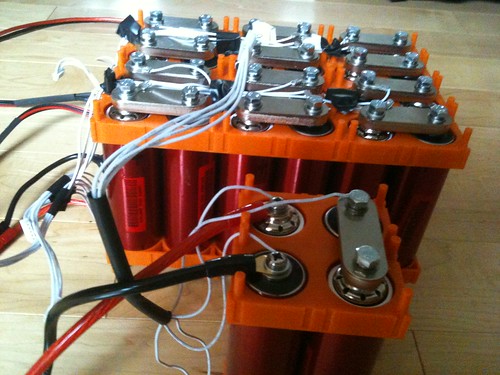veloman said:
So I did the 1/2" copper pipe method, filed it clean, crushed it flat in a vise, drilled it. I did 6 bars - and spent at least 2 hours. Lesson is: buy the headway busbars for 75 cents each.
The headway busbars are apparently plated copper. They are about 1/16" thick which includes the plating, so not much copper in there.
Personally, I like to make sure that when I use energy, that most of it gets to the rear wheel. I do not want to lose energy thru heat in the
bus bar. :wink: Some may argue that it's not much, but when I designed my bus bars, they were for LOW VOLTAGE/HIGH AMPS, so I didn't
want any energy loss.
I learned a lot while figuring it all out. One of my pet peeves is wire sizing. The LOWER the voltage the BIGGER the wire or bar.
Take a look at a car. #4 wire from battery to starter 12v @70amps continuous = 840watts and the wire is fairly short.
In a house, #14 wire 120v @15amps = 1800watts and you can run 60 or more feet with nearly no voltage drop.
Volts is Pressure, and the higher pressure will move the electrons faster so they can produce more work (watts)
If you have Low Pressure, Low Volts, the electrons cant move as fast, a bottle neck affect, and then they just build HEAT in the wire.
So my rule of thumb is, lower voltage BIG wire. Higher voltage Small wire.
On one chart, this was the info:
12v @15 amps 180 watts #14 6 feet max
24v @15 amps 360 watts #14 11 feet max
120 @15 amps 1800 watts #14 wire 68 feet max
So for those running low voltage systems like 24v, they will mostly likely not run more than 11 feet of main pack leads. So #14 wire would be ok
for the 24v 250watt setups.
People running 48v are probably good up to 800-1000 watts continuous with #14 wire, but if they are pulling 4kw from their pack, not good.
I like the higher voltage set ups. I run 84v @ 36amps 3000watts peak in my daily comuter. So #14 wire 1600-2000 watts going thru it? Might just
be big enough, but I run #10 from pack to controller and #8 between packs. The pic below is my A123 132v nominal pack

Each black case is 4S4P 12.8v nominal 9.2ah pack, they are linked in series with #8 wire

I now run 6 cubes 76.8v nom. Below is my 10 cube set up 128v nom

6 cubes with my Grin Ebikes.ca C7225 controller is great for commuting.
Less weight to carry and 33mph/54kph is plenty on a bicycle. It has 700 wh. My commute is 200-300 wh (wind dependent) and I charge at work, so
I use less 50% of the pack. Just how I like it! :wink:
Tommy L sends......




